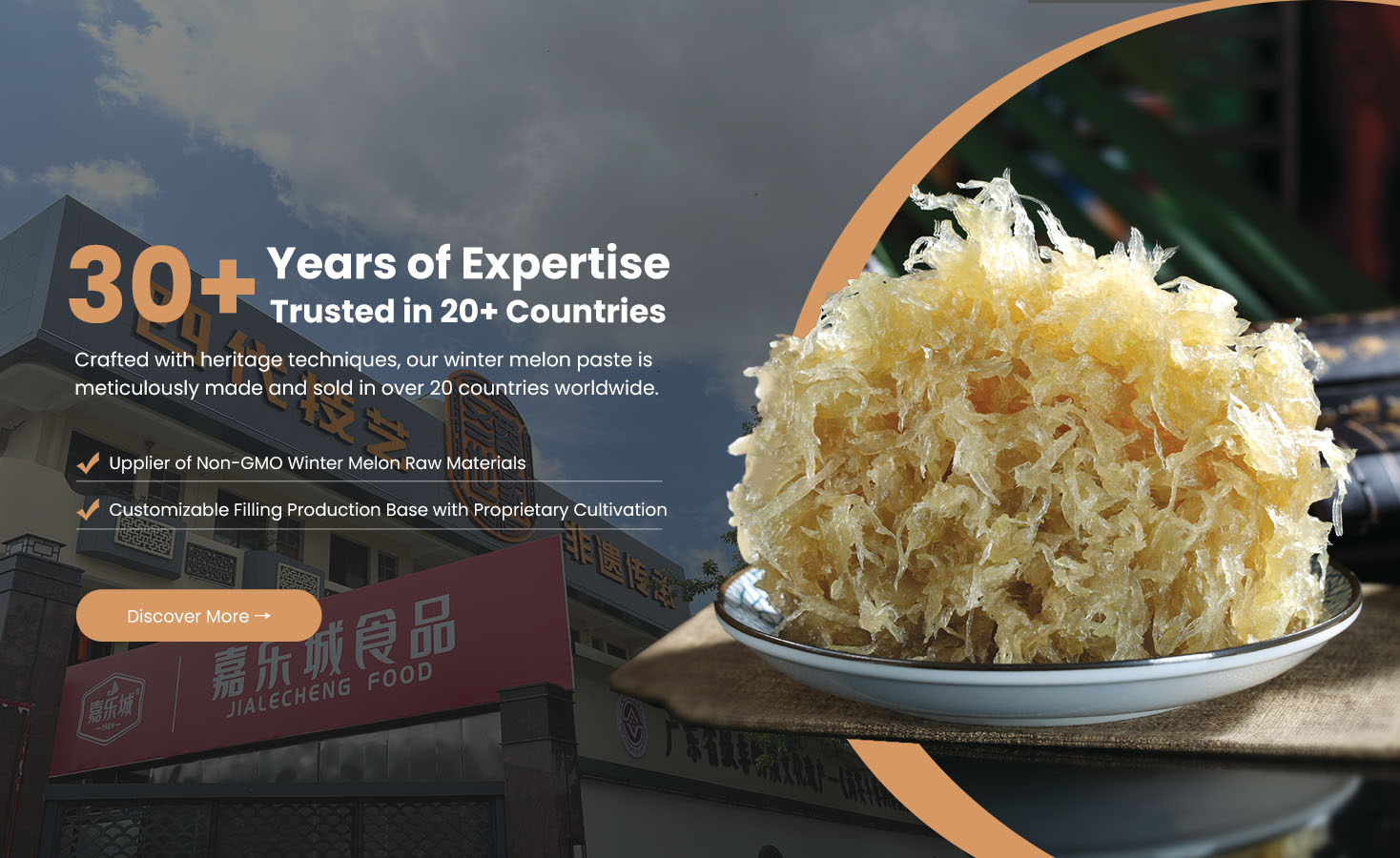What Are The Main Steps in Industrial Winter Melon Paste Production?
The production of winter melon paste at an industrial scale involves a carefully controlled series of steps — from raw material selection to final vacuum packaging — designed to preserve flavor, ensure consistency, and maintain food safety.
Factories like Jialecheng Foods have refined this process over decades, blending traditional craftsmanship with automated food engineering to deliver smooth, glossy, and bake-stable Winter Melon Fillings for pastries such as mooncakes, wife cakes, and fruit-filled buns.
Below is a comprehensive breakdown of each stage in industrial winter melon paste production.
1. Raw Material Selection and Inspection
The process begins with the careful selection of fresh winter melons grown under Jialecheng’s integrated “company + farmer” model. This ensures consistent raw material quality and traceability.
Steps:
Harvesting fully mature winter melons with ideal sugar-to-water ratio.
Visual inspection to remove damaged or unripe melons.
Sampling analysis for moisture content, fiber density, and Brix (sugar) level.
| Quality Standard | Ideal Range |
|---|---|
| Water content | 88–92% |
| Fiber content | ≤ 2% |
| Sugar level (Brix) | 4–6° |
| Flesh color | White, no green or spots |
Only melons that meet these parameters are approved for processing.
2. Cleaning and Pre-Processing
After selection, the melons are washed and prepared for slicing.
Key steps:
High-pressure water cleaning to remove dust and residues.
Peeling and deseeding using mechanical peelers and core extractors.
Cutting into uniform cubes (2–3 cm) for even cooking.
This pre-treatment ensures consistent breakdown during cooking and prevents bitterness from rind or seeds.
3. Blanching and Softening
The diced melon is blanched in hot water or steam to soften its structure and remove any raw taste.
| Parameter | Setting |
|---|---|
| Temperature | 95–100°C |
| Time | 3–5 minutes |
| Purpose | Reduce enzymes, deactivate microbes, improve texture |
Blanching helps the melon release excess water and prepares it for even sugar absorption.
4. Cooking and Sugar Infusion
This is the core step in winter melon paste production. The blanched melon is transferred to steam-jacketed vacuum cookers or large mixing kettles, where sugar, maltose, and water are added.
Ingredients:
Fresh winter melon: 55–60%
White sugar: 30–35%
Maltose or glucose syrup: 5–10%
Vegetable oil or shortening: 3–5%
Process control:
The mixture is slowly heated and stirred.
Sugar melts and draws moisture from the melon through osmosis.
The mixture thickens as water evaporates, forming a semi-translucent mass.
Temperature and viscosity are monitored digitally to prevent overcooking.
| Parameter | Ideal Range |
|---|---|
| Temperature | 95–105°C |
| Cooking duration | 45–60 minutes |
| Moisture target | 25–30% (pre-concentration stage) |
During this stage, maltose syrup prevents crystallization and contributes to the signature glossy finish.
5. Concentration Under Vacuum
To achieve the smooth and dense texture characteristic of professional winter melon paste, Jialecheng uses vacuum concentration technology.
The cooked mixture is transferred to vacuum evaporators, where boiling occurs at lower temperatures (~70–80°C).
This removes excess moisture while preserving the melon’s natural aroma and color.
Continuous stirring ensures uniform heat distribution and prevents scorching.
| Target Parameter | Final Value |
|---|---|
| Moisture content | 18–22% |
| Brix (sweetness) | 68–72° |
| Paste temperature | ≤ 80°C |
Vacuum concentration helps lock in sweetness without caramelizing or darkening the paste.
6. Refining and Homogenization
The concentrated paste is passed through industrial colloid mills or fine grinders to ensure a uniform, silky texture.
This step breaks down any remaining melon fibers.
A consistent particle size gives the paste its smooth, non-grainy mouthfeel.
Oil or flavor additives (like coconut, sesame, or fruit essence) may be mixed in here.
| Equipment | Purpose |
|---|---|
| Colloid mill | Particle reduction |
| Homogenizer | Even fat and sugar dispersion |
| Mixer | Flavor blending |
7. Cooling and Deaeration
The hot paste is cooled to below 40°C using cooling conveyors or closed-loop chillers.
Deaeration removes trapped air bubbles for a denser texture and longer shelf life.
The cooling system also prevents condensation during packaging.
| Step | Temperature | Result |
|---|---|---|
| Cooling | < 40°C | Stable, non-sticky paste |
| Deaeration | Vacuum chamber | Smooth surface, no oxidation |
8. Packaging and Sealing
The finished paste is portioned and packed using fully automated vacuum sealing systems.
Packaging options:
1 kg / 5 kg / 10 kg vacuum bags (for bakery factories)
20–25 kg bulk pouches (for OEM/ODM clients)
Each pack undergoes:
Metal detection to eliminate foreign particles
Weight verification for batch accuracy
Batch coding for full traceability
| Packaging Method | Benefit |
|---|---|
| Vacuum sealing | Prevents oxidation and microbial growth |
| Heat sealing | Ensures airtight protection |
| Label coding | Enables traceability and quality audits |
Shelf life under proper storage (cool, dry environment): 6–12 months.
9. Quality Control and Testing
At every stage, Jialecheng conducts comprehensive quality inspections to ensure uniformity and safety.
| Quality Test | Equipment | Target |
|---|---|---|
| Moisture analysis | Infrared moisture analyzer | 18–22% |
| Viscosity test | Rheometer | Consistent texture |
| Microbiological test | Agar plate method | Safe for export |
| Color check | Digital colorimeter | Light golden consistency |
| Sugar concentration | Refractometer | Brix 68–72° |
All results are digitally recorded in the factory’s quality management system (QMS) for full batch traceability.
10. Storage and Distribution
Finally, the packed paste is stored in a temperature- and humidity-controlled warehouse before distribution.
Storage temperature: < 25°C
Relative humidity: < 60%
FIFO (First-In, First-Out) rotation ensures freshness
For export shipments, paste is palletized and sealed to protect against moisture and temperature changes.
11. Optional Customization and R&D
Jialecheng also operates a research and development lab where fillings can be customized according to client needs. Adjustments can be made to:
Sweetness and Brix level
Color and gloss intensity
Texture (soft, medium, or firm)
Added flavors (coconut, sesame, fruit, etc.)
Sugar-free or low-sugar formulations
Each new formulation undergoes pilot-scale testing and baking simulation to ensure it performs consistently during high-temperature baking.
12. Summary: Industrial Winter Melon Paste Production Workflow
| Step | Process | Key Objective |
|---|---|---|
| 1 | Raw material selection | Stable melon quality and maturity |
| 2 | Cleaning & cutting | Uniform cube size for cooking |
| 3 | Blanching | Remove raw odor, soften texture |
| 4 | Cooking with sugar | Build sweetness and viscosity |
| 5 | Vacuum concentration | Achieve smooth, glossy density |
| 6 | Refining & homogenizing | Create fine, silky paste |
| 7 | Cooling & deaeration | Stabilize and remove air |
| 8 | Packaging | Vacuum-sealed for long shelf life |
| 9 | Quality testing | Ensure texture, moisture, and safety |
| 10 | Storage & distribution | Maintain freshness and consistency |
13. Conclusion
Industrial winter melon paste production is a precision-controlled process that transforms fresh winter melon into a stable, glossy, and flavorful filling suitable for modern bakeries.
By integrating automated vacuum cooking, ingredient standardization, and strict quality testing, Jialecheng Foods ensures every batch meets the same high standard — smooth texture, balanced sweetness, and long shelf stability — ready for export to pastry manufacturers worldwide.




